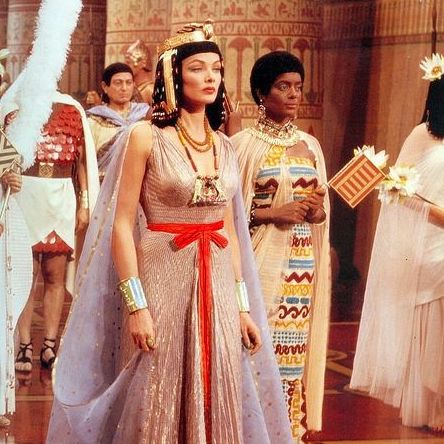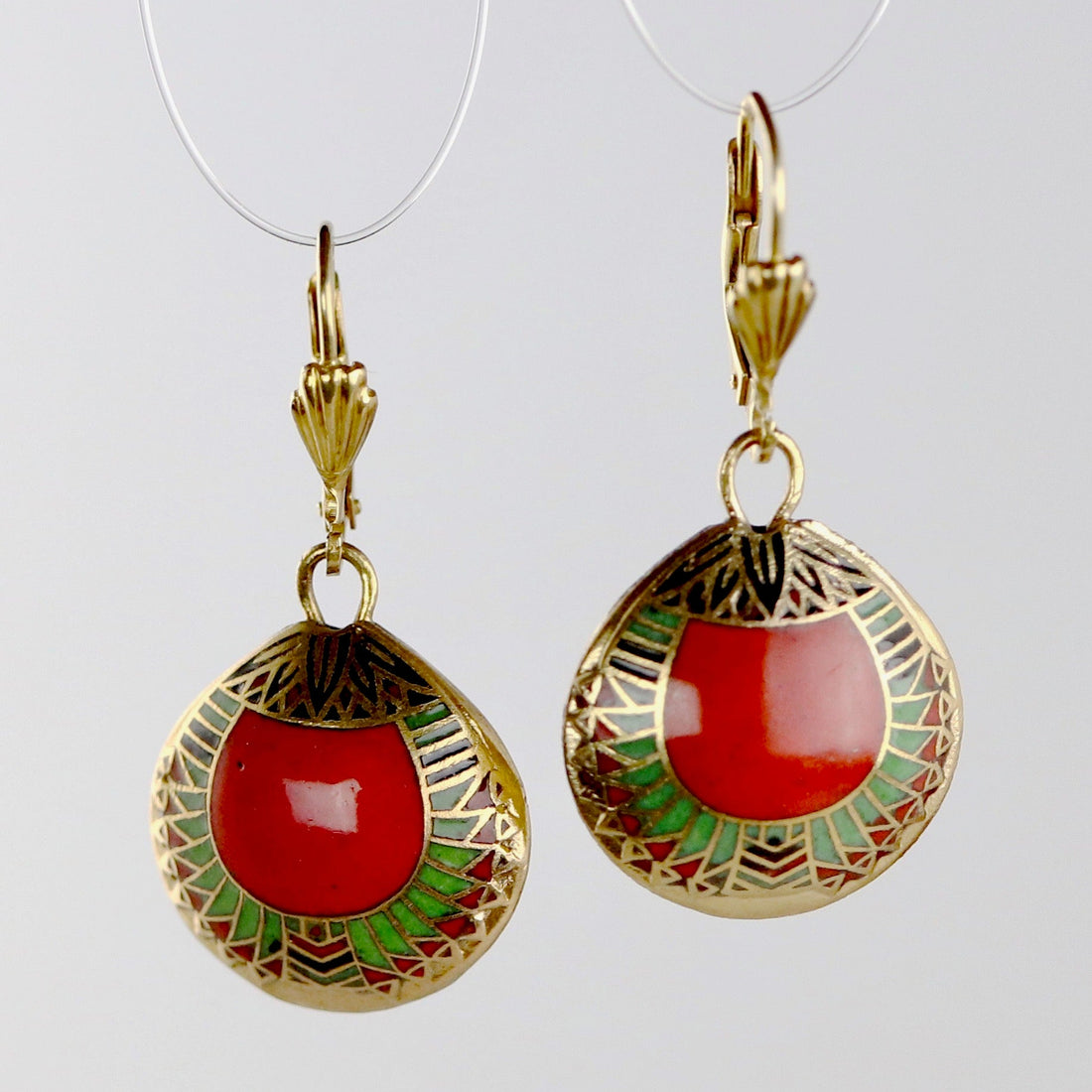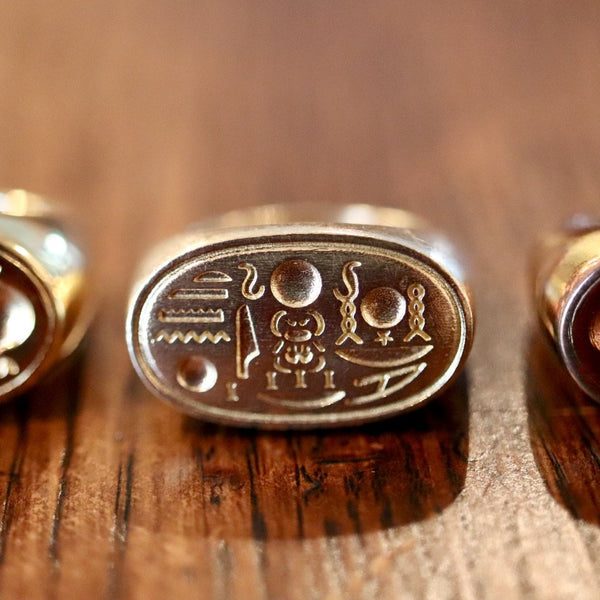A History of Ancient Egyptian Jewelry
Whenever I watch a movie or documentary set in Ancient Egypt, I get distracted by jewelry. Pieces are gemstone forward, made out of exotic materials, stones, and clays, decorated with an abundance of gold, and often cover the entire body.

The Egyptian (1954)
Egyptians have always been portrayed as the elite royals in the history of mankind that adored luxury and power, which is quite true. It has been several thousand years since the first piece of jewelry was made with simplicity, magnificence, and elegance, by the Egyptians. They mastered and invented new technologies and were able to access to various kinds of new metals, gemstones, and creative crafting ideas. Even dictators marvel at the efficiency that was the Egyptian civilization. Fidel Castro said, “The people of Egypt are intelligent people with a glorious history who left their mark on civilization”.
As the Egyptians valued personal adornment, all of the men and women, and even their Holy statues were always beautifully decorated with pieces of jewelry: necklaces, bracelets, earrings, collars, rings, armbands, headpieces, and even anklets, made out of gold and many other precious metals. Jewelry had always held a higher place of significance in the lives of the ancient Egyptians, causing them to have a strong belief in the importance of jewelry. Keep on reading to dive deeper into the history of ancient Egyptian jewelry.
The Meaning Of Jewelry Among Ancient Egyptians:
Ancient Egyptian jewelry was to both beautify the wearer and serve as a talisman of power. It was believed to provide the power protection, good luck, or guidance through the afterlife and could ward off bad luck or evil eye.
Ancient Egyptians had a deep connection with the jewelry and each artifact has a different story to tell. Not only women, but men also adorned their bodies with different jewels made up of precious metals, especially gold and copper, rare stone, intricately carved glass, and sometimes even clay or wooden beads. The higher the status of the man or woman, the precious the jewelry is. Egyptians loved wearing elaborate headpieces, carved rings, dangling earrings, artistic necklaces, and even beard ornaments to display the wealth and power of the Pharaohs.
Precious materials like gold, copper, and gemstones were only worn by the royals and noble families that were specially carved and molded by professional craftsmen of that era. Jewelry also brought a decent amount of income to Ancient Egypt through trade to countries like Ancient Persia, Turkey, Greece, Rome, etc, because of the detailed carvings, metalwork, unique beaded structures, and precious stones work that was the forte of Egypt. The Egyptian art of jewelry making can be recognized from afar because of its unique features, motifs, and distinctive use of materials. Jerry Saltz rightly stated
“The style of ancient Egyptian art is transcendently clear, something 8-year-olds can recognize in an instant. Its consistency and codification are one of the most epic visual journeys in all art. One that lasts 30 dynasties spread over 3000 years.”
Materials available in Ancient Egypt:
Egyptians used a variety of precious and semi-precious materials to define their status and protect their bodies from negative energies. From metals to clay to woods to precious and semi-precious stones, ancient Egyptians incorporated different materials in their jewelry making. Here are the main techniques and materials that the ancient Egyptian jewelers and craftsmen used to make jewelry for the royals and noble families.
Gold and other Precious Metals:
When gold was discovered along the river of Nile, Egyptian created gold mines to extract as much gold as possible.
At first, the gold was used to pay tribute to holy entities and adorn the statues of their Gods. However, with time gold became a major part of the everyday accessories of the royals and noble families of Ancient Egypt. The gold was carved and molded into rings, beads, and headgear of the pharaohs.
Shown: Met Museum's Ring showing Shu and Tefnut - a Finger Ring representing King Akhenaten and Queen Nefertiti as Shu and Tefnut (ca. 1353–1336 BC) reveals the reign of King Akhenaten and Queen Nefertiti, the father and mother of Earth and Sky, with the sun above them and the Earth beneath them. Our Nefertiti's ring is an exact replica of this seal ring that was the trademark of King Akhenaten.
Wooden and Ceramic Beads:
Apart from the precious metals and stones, the ancient Egyptians used woods and ceramics to create different shaped beads for their headgear, neckpieces, and bracelets. Faience beads were quite famous for both the living and the dead in ancient Egypt.
Egyptian Faience - a clay mixed from sand, limestone, soil, dirt and a bit water would be shaped and then fired at low temperature to make a glossy hardened beads, animal figurines, and sculptures.
Shown: Mummy beads. We offer them in turquoise, earth-tone small, and earth-tone large varieties. Authentic Egyptian faience beads such as these are 2000 -3000 years old.
Apart from the precious metals and stones, the ancient Egyptians used woods and ceramics to create different shaped beads for their headgear, neckpieces, and bracelets. Faience beads were quite famous for both the living and the dead in ancient Egypt. Our Queen Hatshepsut Necklace for example is made up of authentic 3000-year-old faience beads in red, yellow, turquoise, and earthy brown colors, designed by a renowned Egyptian jewelry artist. There are 200 beads per chocker, showcasing the grandeur of ancient Egyptian jewelry.
Precious and Semi-Precious Gem Stones:
Stones had a great significance in ancient Egyptian history. Most stones were known for the properties they held in terms of their colors. Lapis lazuli provided deep blues and calming. Turquoise which was sourced and imported from the mines in the Sinai Peninsula provided sea blue-green and protection.
The vibrant red-orange carnelian stone was known for its healing and protective energy was widely used in ancient Egypt. It was admired by the pharaohs and noble families of that era. Carnelians were believed to have talisman powers that could protect the wearer from bad luck and the evil eye.
Shown: Our Red Sea Carnelian Earrings feature hand-carved carnelian scarabs, they are one of our most iconic replicas of Ancient Egyptian jewelry.
Enamel:
Late Egyptians were among the first people to melt glass powder and fuse it onto objects, ceramics, and jewelry. Today we know the technique as vitreous (or glass) enameling.
Shown: Vintage Shashi Scarab Earrings in red - also available in black and purple.
Marble and Stone:
Marble, a stone that was one of the building blocks of the ancient Egyptian history, was also used as an ornament to decorate and beautify the vanities and the living space of the pharaohs.
Shown: the Ra-Harakht Falcon is a piece of noble jewelry that is carved to perfection, for the surroundings of the Royals. The shape of the falcon demonstrates the noble nature of God “Ra” who could take the form of the bird and control the sun with his wings.
Techniques used in Ancient Egyptian Jewelry:
Cartouches:
A cartouche (oval enclosing hieroglyphs - usually with a line on one end) was a collection of symbols arranged in the form of a name or title. They were used to name specific Pharaohs and were later used by upper classes. Egyptians believed one who's name was transcribed somewhere was never truly dead. King Tut, Ramses II and Nefertiti might attest to the truth of this belief.
Shown: Ring Tut (available in plated brass, silver or brass). The cartouche depicts the throne name of the Pharaoh Tutankhamun. It would have been used to seal wax stamps and worked as a trademark of the Pharaoh. The original was made entirely of Gold and shows the detailed craftsmanship of the Dynasty 18. It was made during the reign of Tutankhamun, which is also known as the late bronze age. This seal ring holds great importance as it was used to seal wax stamps and worked as a trademark of the Pharaoh.
Hieroglyphics:
Hieroglyphs were one of the main designs that were found on Egyptian jewelry. As mentioned above, Egyptians took their jewelry seriously and each artifact has a different story to tell. To explain important facts about the time and ownership of the jewelry, hieroglyphs were vastly used.
Shown: our Ring of Priest Sienamun borrows its hieroglyphics from an original at the Met Museum.
Scarabs:
Scarab, a beetle that had a great religious value in ancient Egypt and was known for the idea of rebirth and regeneration, was one of the vastly used motifs in ancient Egyptian jewelry making. They were etched into stones, carved into wood, and engraved into metals and worn to honor the God of the Sun “Ra”.
Shown: our Laurel Burch Scarab Earrings feature a sacred scarab etched on silver-plated brass.
Deities and Iconography:
The representation of Gods and Goddesses in the form of jewelry was quite common in Ancient Egypt. Each pharaoh wore pendants, amulets, rings, and headpieces representing the iconographic Gods they worshiped.
Shown: Vintage Isis Silver Earrings designed by the late artist Laurel Burch pays tribute to Isis, the Goddess of life and magic.
The goddess Isis as well as her extended family Horus, Set and Ra are well represented in ancient egyptian art and jewelry, and consequently are well represented in our jewelry lines.
The Egyptian civilization back in the ancient times had unique minds that came up with mind-blowing ideas and inventions. But technology was not the only thing they had their focus on. They, no doubt, led a very luxurious and royal life, which led them to be the greatest jewelry makers and trendsetters of all time. They came up with unique and intricate designs for their over-the-top jewelry pieces and made the style last for a long time, inspiring everyone along the way.
The history of ancient Egyptian Jewelry was not only deep and mysterious but also had tons of secrets hidden within them. For ancient Egyptians, jewelry was not only for the living but the deceased ones as well. The ancient Egyptian history, including their unique relationship with jewelry, will always hold a very significant place in the list of the greatest civilizations that had left a huge mark in history.
Egyptian Jewelry for Sale:
Our collection of Egyptian jewelry includes artifacts such as mummy beads, replica pieces, and period inspired designs.









Comment
I have this necklace thats has Egyptian writing on it and I cannot figure out what it says I looked up Egyptian writing and try to figure out and that’s the pictures but there are some pictures that I couldn’t find them there so if you guys can try to figure out what is says